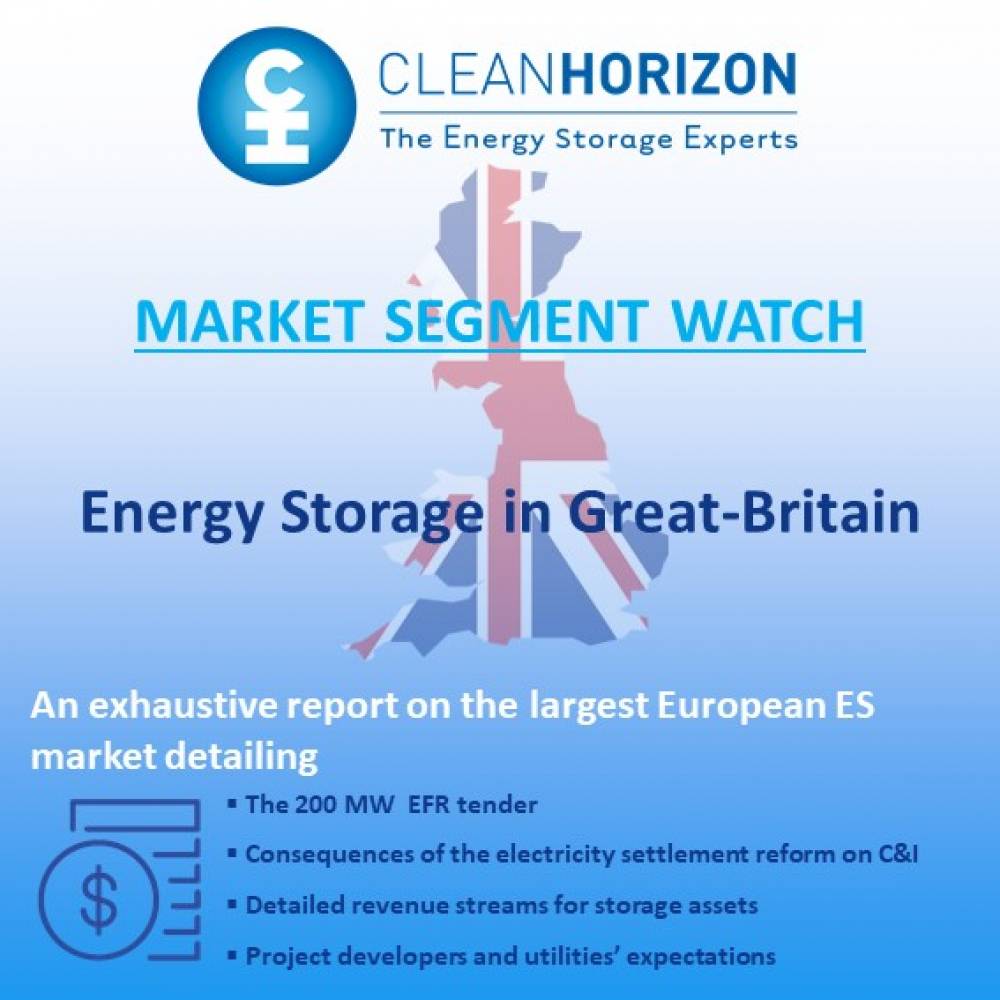Market Segment Watch Great-Britain 2016
1000 €
Get detailed revenue streams energy storage assets can benefit from in Great Britain (EFR 200MW tender, FFR, FCDM, Triad and distribution charges avoidance, distribution network support, residential storage) as well as recommendations for manufacturers and integrators based on GB project developers interviews.
Description
Key questions addressed:
How does the GB energy market work?
What are the revenue streams for energy storage assets?
What are the emerging business cases for energy storage projects in GB?
What do project developers expect for their projects?
What are the needs of the technology end-users?
Who needs this report?
Energy storage equipment manufacturers
Integrators looking at the GB market
Project developers willing to better understand the GB market
Investors willing to better understand the risks associated with storage and the revenue streams
Utilities looking for opportunities with energy storage
Commercial and industrial electricity consumers
TABLE OF CONTENTS
Executive summary 1
Introduction 5
1. The electricity supply chain in Great Britain 6
1.1 Generation 6
1.1.1 UK electricity mix 6
1.1.2 The electricity market 7
1.1.3 Renewable targets 7
1.1.4 Small-scale renewables support 9
1.1.5 Large-scale renewables support 9
1.2 Transmission 10
1.3 Distribution 11
1.3.1 The Distribution Network Operators (DNOs) 11
1.3.2 Issues on the distribution network 11
1.4 Supply 12
1.5 Consumption 12
2. Revenue streams for energy storage systems 13
2.1 Power intensive services to the grid 14
2.1.1 Enhanced Frequency Response (EFR) 14
2.1.2 Commercial Frequency Response (CFR) 15
2.1.2.1 Frequency Control by Demand Management (FCDM) 15
2.1.2.2 Firm Frequency Response (FFR) 15
2.1.3 Fast reserve 17
2.2 Energy intensive services 17
2.2.1 Participation in the Balancing Mechanism (BM) 17
2.2.2 Short Term Operating Reserve (STOR) 19
2.2.3 Demand Turn Up (DTU) service 19
2.3 Distribution network support 20
2.4 The Capacity Market (CM) 20
2.5 Embedded benefits for commercial and industrial applications 22
2.5.1 Transmission fees avoidance (TNUoS charge) 22
2.5.2 Distribution fees avoidance (DUoS charge) 23
2.6 Residential 24
2.6.1 Residential storage system 24
2.6.2 PV plus storage 25
3. The promising revenue streams for storage according to Clean Horizon 25
3.1 Ancillary services 26
3.2 Transmission and distribution fees avoidance 26
3.2.1 Market size to double in the coming year 26
3.2.2 Increasing charges 27
3.3 Emerging business case for storage: combining services 28
3.4 Risks linked to those revenue streams 29
4. Presentation of the customer survey 30
4.1 Structure and aims 30
4.2 Results and recommendations 30
4.2.1 Current level of implication regarding energy storage 30
4.2.2 Storage technologies considered 31
4.2.3 Applications considered 32
4.2.4 What would facilitate storage project development 32
4.2.4.1 Regulatory changes 33
4.2.4.2 Technical advisors 33
4.2.4.3 Market and Business cases intelligence 33
4.2.5 Favourite partners of project developers for energy storage issues 34
4.2.6 Solutions that project developers buy 34
4.2.7 Guarantees project developers look for 35
4.2.8 Financing the chosen solutions 36
4.2.8.1 Criteria for the choice between project finance and corporate finance 37
4.2.8.2 Criteria for the choice between equity and debt 38
4.2.8.3 Bankability issues 38
4.3 List of recommendations 38
4.3.1 Recommendations for vendors 38
4.3.2 Recommendations linked to financing 38
4.4 List of participating companies 40
Conclusion 41
TABLE OF FIGURES
Figure 1: Gross UK generation mix evolution from 2012 to 2014 6
Figure 2: Wholesale electricity prices on the day-ahead market from 2013 to 2015 7
Figure 3: Link between renewable energy sources penetration and energy storage 8
Figure 4: Implementation of the Electricity Market Reform (EMR), from RO to CfD 9
Figure 5: Electricity transmission 10
Figure 7: Unplanned SAIDI including exceptional events in 2013 in the UK 11
Figure 8: Non-HH metered profile classes and their characteristics as of March 2016 13
Figure 9: Two remuneration strategies for energy storage systems 13
Figure 10: EFR product characteristics 14
Figure 11: Commercial Frequency Response products characteristics 15
Figure 12: April 2016 amount of dynamic FFR required 16
Figure 13: April 2016 amount of static FFR required 16
Figure 14: Balancing market-net imbalance volume (long and short system) 18
Figure 15: Monthly average system price over the last year 18
Figure 16: Transmission zones and fees on the 1st April 2016 23
Figure 17: Table summarising the different revenue streams for an energy storage asset 26
Figure 18: Breakdown of energy users by metering type as of December 2012 26
Figure 19: Breakdown of energy users by metering type as of March 2016 26
Figure 20: Number of HHM consumers and annual energy imported 27
Figure 21: Historical and expected demand tariff for TNUoS 27
Figure 22: Estimated future Triad average demand 28
Figure 23: Triads during winter 2015/16 30
Figure 24: Involvement of project developers regarding energy storage in GB 31
Figure 25: Technologies considered by project developers for their projects 31
Figure 26: Applications considered by developers 32
Figure 27: Missing elements according to project developers 33
Figure 28: Favourite interlocutor of project developers 34
Figure 29: Solutions project developers look for 35
Figure 30: Guarantees project developers look for beyond 2 years parts and labour 36
Figure 31: Financing solutions chosen 37
Figure 32: Two different reasoning patterns regarding the financing method 37
